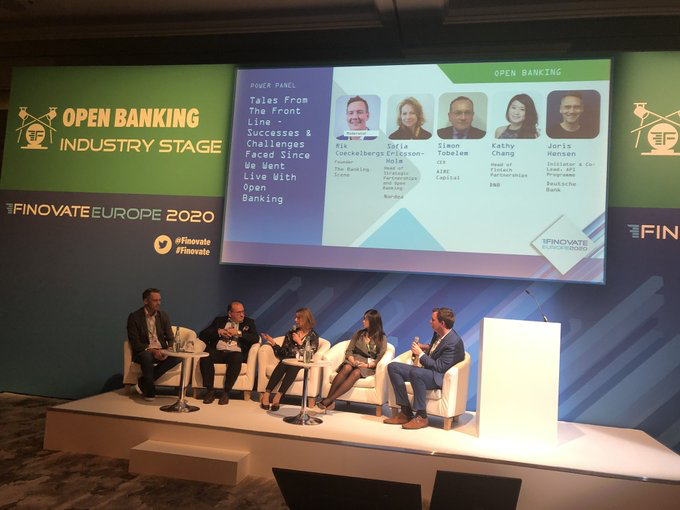
Insights & Opinions
“Successes & Challenges Faced Since We Went Live With Open Banking”
Tue, 25 Feb 2020

A few weeks ago, I had the opportunity to moderate an Open Banking panel at Finovate Europe. I made it my personal challenge to make we would bring something new to entertain the crowd.
Luckily, I had the topic at my side: “Tales From The Front Line — Successes & Challenges Faced Since We Went Live With Open Banking”. With the Open Banking Interviews this is what I do: ask people from the front line how to make Open Banking a success.

Talking about the Open Banking Interviews: one of the panellists was a familiar face: Joris Hensen, the first one I ever interviewed in the Open Banking Interview Series. The complete list was:
- Joris Hensen, Founder and Co-Lead of Deutsche Bank’s API Program
- Sofia Ericsson Holm, Head of Strategic Partnerships at Nordea
- Kathy Chang, Head of Fintech Partnerships at DNB
- Simon Tobelem, Co-Founder of ARIE Capital Group.
This was a great, diverse group of people, both geographically as in the way they approach Open Banking in the institutions they represent. As these banks all started well before the famous date of 14 September, their evaluation period wat not 4 months, but sometimes up to 4 years.
What were my 3 key learnings of this panel?
1: There is no one size fits all
Open Banking is still relatively new. Even though some banks are experimenting with APIs for a long time, the other stakeholders may not be doing so. How experienced is the end-user, the developers? The regulator?
Like in any innovation, there is one thing to keep in mind: it is still an experiment to some extent, which implies there is still a high level of uncertainty of success and a low appetite for change. Because there is a high uncertainty for success, it is important to keep your eyes, and thus also your scope, wide open.
What makes Open Banking successful? Don’t look at it like it is a payments strategy. Open Banking is a lot bigger than that. By looking at the big picture, you will also find a lot more opportunities, and learning from the failures you encountered. Product Market Fits sometimes works, sometimes they don’t. This requires a lot of dialogue with the market.
2: Change the organisation, but start small
Unlike new banks like N26 etc., banks are not used to integrate third-party services, they haven’t learned to easily partner up, and they often don’t have the infrastructure to do so. Transformation doesn’t happen from one day to the other.
Change management is an essential part of a successful Open Banking Strategy. Make sure you list all of your key stakeholders, the ones that are directly impacted. Not everybody needs to work with APIs, you don’t need to change the whole organisation. Change takes a lot of energy, use it wisely with the ones that need it.
Once you listed your key stakeholders, it is important to get their buy-in. Make sure they understand why they are pulled in the project. APIs are about bringing value to the customer, that is how to motivate your employees. The best way to teach someone about the added value of an API is by showing the outcome, not by explaining how it works. Learn what Open Banking brings to the customer, then explain what it is all about, finally explain how to deal with it daily.
In the case of Deutsche Bank, a Hackathon was a great way forward. This helped the organisation to demonstrate concrete Open Banking outcomes. Perhaps more important was the internal communication of the results of these solutions.
3: APIs: start with the WHY, with a clear value proposition
An API economy is not about the API, it is about the value it generates. What makes using API relevant?
Are APIs the only way forward when it comes to Open Banking? Sometimes you don’t even need APIs. There are markets where alternative solutions are common and accepted for use cases where APIs are currently not providing the right value. Some banks in the panel did confirm the message of Davy Kestens: if the industry wants to use only APIs and no alternative technology, they should make sure the APIs are more user-friendly than the alternatives (like web scraping or reverse engineering).
The main challenge for fintechs that need to talk to banks for better, easy-to-use APIs is not so much the culture, like I assumed, but more the absence of purpose for a well-functioning API platform at bank-side, according to some of the panellists. For many banks today, the relevance of APIs is to be compliant. They don’t see how it creates value in the short run.
PSD2 lacks a monetisation model at the moment, despite all the opportunities for third parties to make a decent business model with revenues out of it. In other words: they miss the real business rationale of APIs.
4: Create a trusted Open Banking environment
‘Environment’ is, in this case, the whole ecosystem around Open Banking, not just the platform, the sandbox, the APIs, but also the developers, end-users, bank employees, supervisor…
The technology is a given, but how to deal with all the rest? Trust is very important to make Open Banking a success.
The challenge of trust in Open Banking lies in the multitude of intermediaries: bank — developer — end-user… banks can play a role here: they set the standard of trust and they are the one the end user looks at to make sure who he can trust.
We already talked about how to get internal buy-in for Open Banking, but of the same importance is the external one. Communication is the secret sauce here. Make sure as a bank you avoid the bad publicity from fintechs that struggle with APIs. Spend sufficient time and development in the right communication tools. Some banks invest at least as much in well-functions communication platforms as they invest in the APIs. That is what will make it a success at the end.
Managing expectations towards fintechs is key. You can create a lot of value out of APIs but if you don’t communicate in a very concrete way, the expectations may be different, which will confuse the developer world. That will negatively impact trust in the context of Open Banking.
5: Creating THE platform should not be the end-goal
Becoming THE platform is a business opportunity, not THE business opportunity. We also talked about the different roles on the platform. Next to the facilitator of the platform and the service supplier, there is also the orchestrator of the platform. The shift in terms of the business model is challenging. Each bank should decide within his context how to deal with this. It depends on what your focus is, and what your strength is, even for the biggest banks a platform and being present on other platforms is needed to make sure all customers are served according to their needs.
Perhaps we can get inspiration from elsewhere, but it is not the general truth. Look at the big platforms of today: they became successful by building on their key strengths in a small niche where they were really good and they built their business from there to something a lot bigger. We should not forget either that all these platforms are also present on third-party platforms. From Uber to Google, Facebook… they are all intertwined with different propositions.
6: What’s next? When will we see the real value creation of Open Banking?
Very likely this is not something a bank should do on its own. One of the participants remarked that bringing value to the end consumer should not just be about sharing financial data. True value comes from different data from different sectors. How can we develop to an Open Economy? Once data sharing becomes the new normal, it will also be more trusted.
So where should banks look at? Perhaps the niche of trust would be the right starting point. This is where banks have always been really good at in the past. Consider which product you can build on this asset.